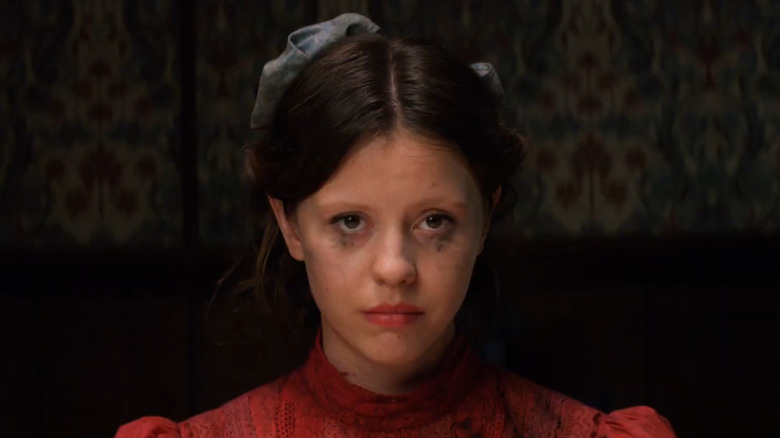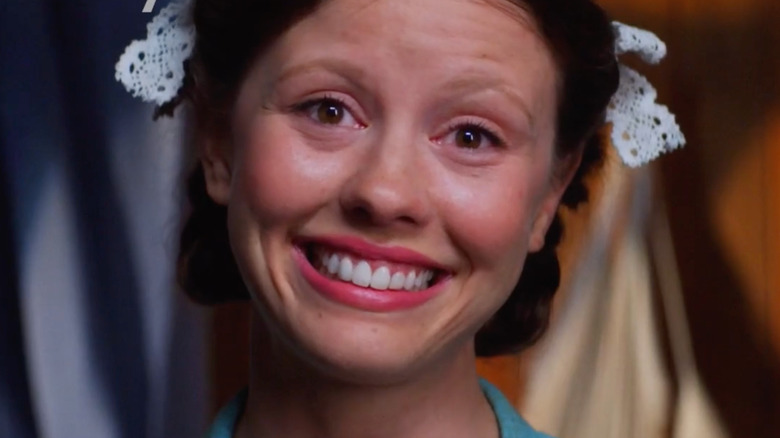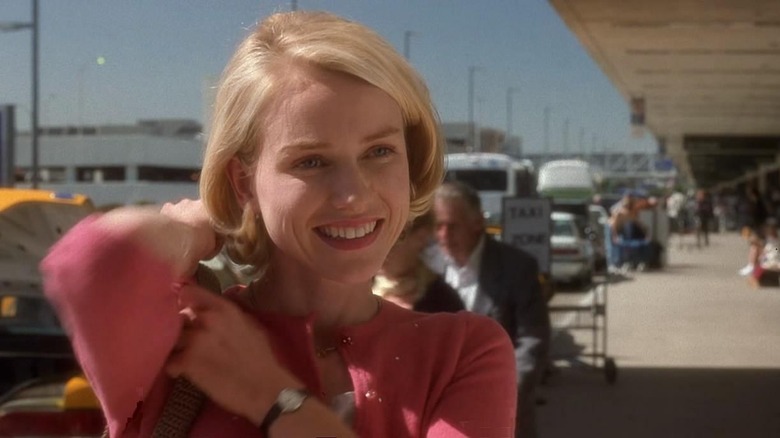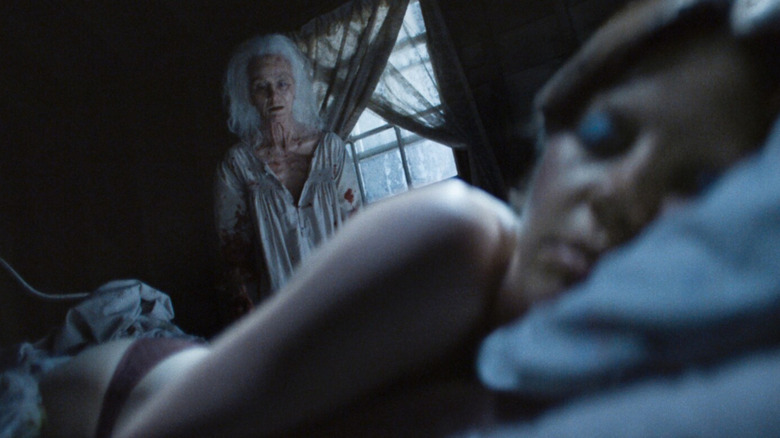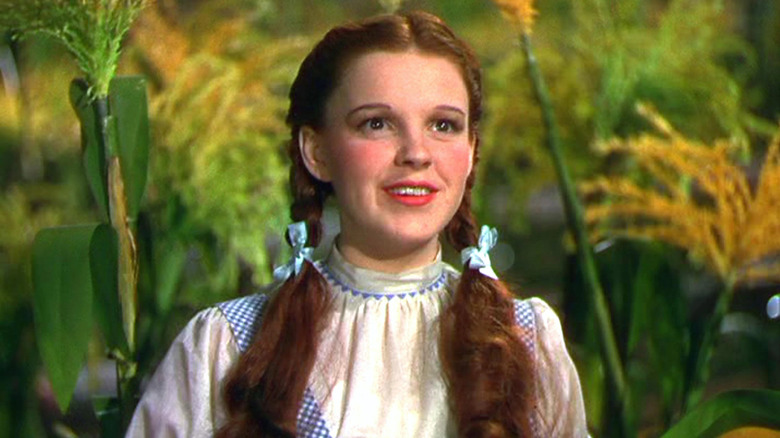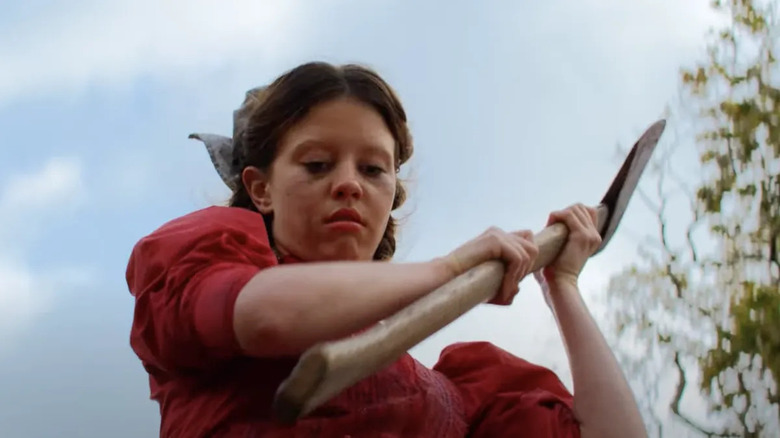Pearl Ending Explained: A Star Is Shorn
One of the core tenets of American mythology is the "rags to riches" story, the idea that any anonymous individual can, through sheer ambition and force of will, achieve lasting success in life. Nowhere is this myth best utilized than in the numerous stories about people making it big in show business. Most films about this topic throw enough hardship at their protagonists to keep things feeling realistic, but they make sure to perpetuate the myth: most of these stories have a happy ending worthy of a fairy tale.
"Pearl" is a different kind of fairy tale, and its emotionally harrowing finale subversively looks like a Technicolor happy ending while being anything but. This shouldn't come as much surprise to those who saw "X," which was co-writer and director Ti West's initial installment in what we now know is a trilogy of films. In "X," star Mia Goth portrayed both that film's nubile lead, Maxine, as well as the octogenarian version of Pearl, a woman who had dreams of stardom but got stuck on the same farm all her life and became a vicious killer.
The clever genius of "Pearl" as not just a standalone film but as a prequel to "X" is that "Pearl" isn't so much a study of how the killer of "X" came to be, but a look into why. It's West and Goth's mean little riff on Technicolor musicals and the '50s "women's picture," a heartfelt story of neither a rising star nor a has-been, but a never-will-be.
There's no place like home, there's no place but home
Even though "Pearl" isn't paying homage to vintage '70s and '80s slashers like "X" had done, it still features a similarly single-minded structure and economy of location. Set in 1918 on the same small-town Texas farm as in "X," "Pearl" sees the titular young girl trapped in a near-squalid existence by her overbearing German immigrant mother, Ruth (Tandi Wright) and her invalid father (Matthew Sunderland). The only moments of happiness Pearl enjoys involve her fantasies of becoming a star performer, and these fantasies grow after she meets the Projectionist at a local movie theater (David Corenswet) and hears from her sister-in-law, Mitzy (Emma Jenkins-Purro) that a dance troupe is holding auditions in town soon.
Pearl becomes seduced in a number of ways over the course of the film. For one, she's shown an underground European stag film by the Projectionist, and her adulterous relationship with him further equates the notion of stardom and sexual expression in her mind. For another, the advice she receives from both the Projectionist and Mitzy inspires her to stand up to Ruth, and the latter woman's strict methods and stifling of Pearl's self-image causes Pearl to accidentally set Ruth ablaze during a fight. Passing the point of no return, Pearl allows Ruth to perish in the basement of the farm home, euthanizes her father, and murders the Projectionist when she feels he doesn't like her any more.
All of that seems acceptable to Pearl, as she has now convinced herself that these events mean that she's destined to be whisked away to a life of fame and fortune — while waiting to audition for the troupe, she repeats "it has to be me" like a mantra. When Pearl is rejected by the troupe, she confesses her crimes both literal and emotional to Mitzy, who Pearl believes got the dance gig over her. No longer liking or trusting Mitzy, Pearl murders her, then "fixes" her own life by propping up the corpses of her dead parents at the kitchen table as if everything was fine. When Pearl's soldier husband Howard (Alistair Sewell) finally returns from the war, he finds his wife presiding over this ghoulish facsimile of a happy home. Pearl has made a new fantasy, one that's superseded reality.
The great lie of cinema and stardom
Like all the greatest slashers, "X" had a number of subtextual layers to it, commenting on everything from the hardships of old age to the relationship between sex and death and the way cinema depicts the two. "Pearl" deepens and expands those themes as it presents cinema as a seductive force in and of itself, a trigger that clashes with the suppressed existence Pearl suffers.
While Pearl has already been married to Howard long before the film begins, West depicts Pearl's deeper sexual awakening when she humps a scarecrow to climax while imagining it to be the Projectionist. Sure enough, in the shame of afterglow she becomes violently angry. It's an indication that Pearl is attempting to find a path to sexual and emotional freedom that her upbringing and society won't allow.
This merging of sexual expression and cinema as a seductive lie has been seen before, most notably in several of the films of David Lynch. In both "Mulholland Drive" and "Inland Empire," women who either are or aspire to be actresses find their identities lost and fractured within the conflicting messages of Hollywood and society at large, and it's just such a struggle that Pearl endures. As a sly commentary on the supposed virtues of ambition, Pearl deludes herself into believing her actions are justified because her destiny is written in stone, only to become more self-aware and more psychologically broken once that dream is crushed.
A pandemic movie in more ways than one
"Pearl" was written by West and Goth at the arguable height of the pandemic in fall of 2020, during the two-week quarantine they underwent before shooting "X" in New Zealand. It makes absolute sense that the Covid-19 outbreak and its effects on culture would be reflected in the movie, but it's done in a very clever way: by incorporating the outbreak of Spanish Flu in 1918, West has a historically accurate reason to feature characters wearing protective masks in the film. It makes "Pearl" and its many allegories feel that much more relevant and immediate. When the Projectionist observes at one point about how it's hard to tell who people are when they're wearing masks, the film clearly intends that literally and figuratively.
West also revisits the themes of "X," commenting on the cyclical nature of violence through a historical lens. Where "X" featured Goth playing two sides of a generational coin in Pearl and Maxine, "Pearl" always keeps the horrors of World War I lurking in the background. Pearl's suffering father is a constant reminder of the ravages of war and sexually transmitted disease, while even the newsreels at the cinema feature horrifyingly graphic footage of wartime violence.
It all adds up to the final moment of soldier boy Howard returning from the Front to find even greater, grislier violence waiting for him in his own isolated home. As America and the world were to discover not too long after 1918, widespread horror and violence did not end with WWI.
West and Goth twist the musical and women's picture toward horror
The ultimate sly commentary of "Pearl" lies in the way the film makes a vicious killer utterly sympathetic. Granted, there have been numerous movies that have tackled such subversion, from "Henry: Portrait of a Serial Killer" to "American Psycho" to even, arguably, "Psycho." Yet the satire of "Pearl" is primarily visual, using the iconography of musicals and the woman's picture to play on the audience's sympathies.
As West explains via a press kit from A24, one of his biggest influences was "The Wizard of Oz":
"It's a movie that deals with fantasy and imagination, the hardships of growing up on a farm and wanting to escape. It was in the ether when I wrote 'Pearl,' much in the same way 'The Texas Chain Saw Massacre' was when I wrote 'X,' but they wound up being very different movies. There's something fun about thinking as a viewer that you know what a movie is going to be, but having the filmmaker ask you along the way, 'Are you sure?'"
Besides musicals like "Oz" and "Mary Poppins," the other classic Technicolor films West references with "Pearl" are the women's pictures of the 1950s, specifically those of Douglas Sirk, Max Ophüls, and George Cukor. Their films follow female protagonists who endure large amounts of emotional distress (enhanced by their circumstances and position in society) until they reach a breaking point. Of course, Pearl's breaking point means murder, but the film has no less sympathy for her character.
Pearl is Goth's tour de force
The fact that Pearl remains so sympathetic throughout the film is its ultimate triumph. It's not only a homage to the films West references as well as a throwback to films like those of Robert's Altman ("That Cold Day in the Park," "Images," "3 Women") and Aldrich ("What Ever Happened to Baby Jane?"), but the approach allows West and Goth to tie the horror and subtextual commentary together. After all, it's no coincidence that Cukor directed the 1954 version of "A Star Is Born" that stars Judy Garland, who also starred in "The Wizard of Oz."
Of course, none of this would work without Goth's incredible performance. She makes Pearl thoroughly watchable and even likable, even when she's at her most despicable. As West explains, "If you've seen 'X,' then you know that Pearl's life didn't turn out the way she wanted, and she goes on to do some terrible things. But even though this character has demented issues [...] you still want things to work out for her." The final long, unbroken take of Goth's face that occurs during the film's end credits encapsulates the fear, pain, loss and menace of Pearl, making the ending a happy one only in her mind.
